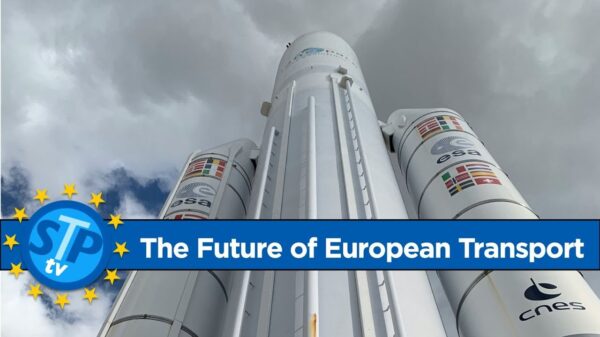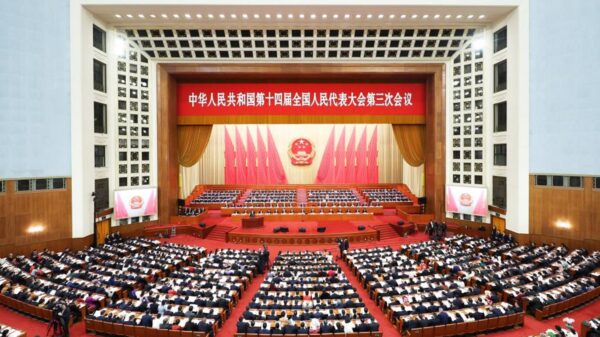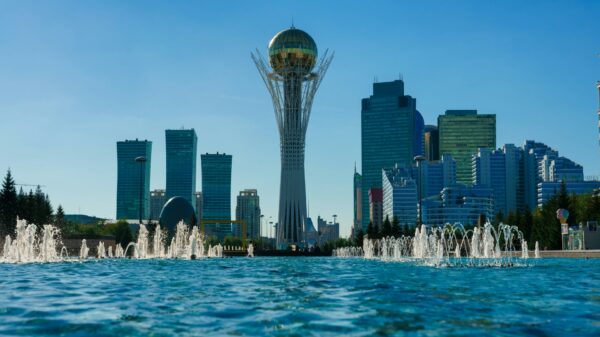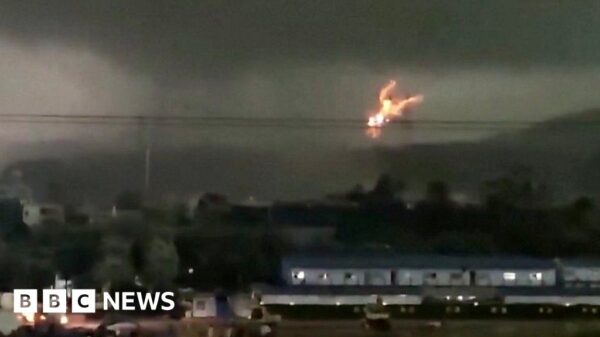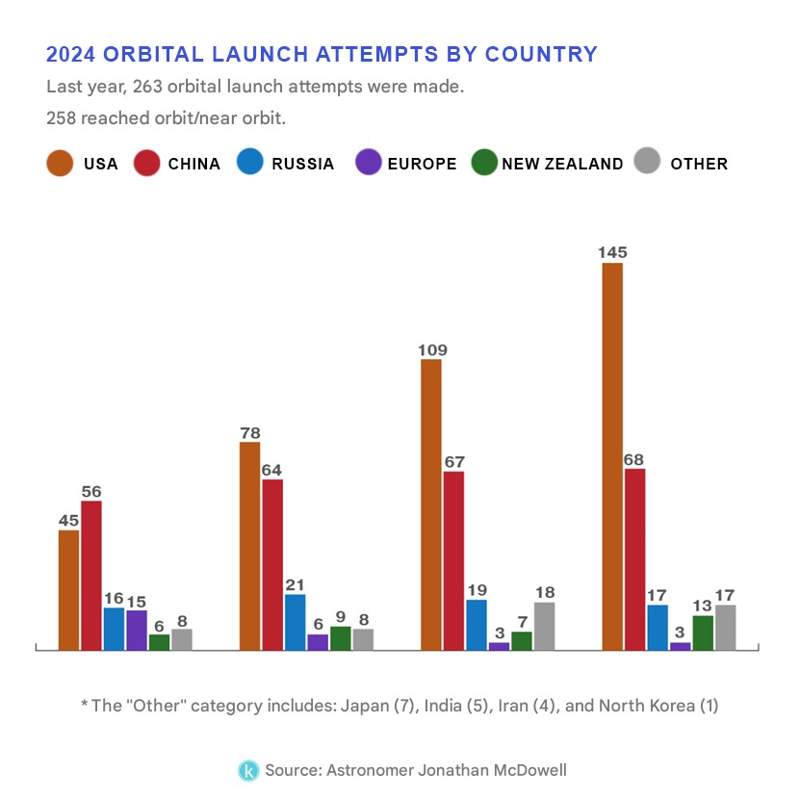“If Beijing gets there first [to the Moon], it could say: “Okay, this is our territory, you stay out.” This concern was once voiced by NASA Administrator Bill Nelson. How the two superpowers plan to “divide” space is explored in Kazinform’s News Agency correspondent report.
The US is determined to maintain its lead in space
In 2024, the number of rocket launches in the US increased compared to China and other countries, including Russia, the EU nations, and New Zealand.
The US carried out 145 launches, with 138 of them—95%—conducted by SpaceX (132 – Falcon 9, including one failure, 2 – Falcon Heavy, and 4 – Starship). The remaining 7 launches were distributed among other providers: ULA Atlas V – 2, ULA Vulcan – 2, ULA Delta IV – 1, Rocket Lab Electron – 1, and Firefly Alpha – 1.
China launched 68 spacecraft, surpassing its totals from 2023 (67 launches) and 2022 (64 launches). The Long March 2D rocket was launched nine times, while Galactic Energy’s Ceres-1 completed five flights. Notably, commercial rockets accounted for 70% of China’s launches, marking a 65% increase compared to 2023 and a 55% increase compared to 2022.
In 2024, Beijing officially included commercial spaceflight in its list of priority emerging industries. As of today, China has 77 NewSpace startups, with 47 backed by the government and 21 receiving A+ funding (capital investment from private investors).
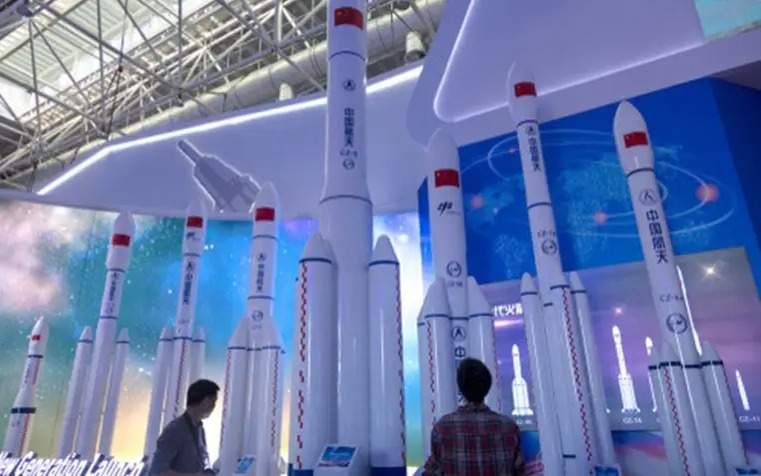
The top five Chinese space companies are:
· Landspace – develops ZQ-1 and ZQ-2 launch systems, as well as the Tianque 80t and Phoenix 10t liquid rocket engines ($335 million in funding).
· iSpace – working on commercial Hyperbola-1 and Hyperbola-3 rockets ($273 million).
· Galactic Energy – a commercial rocket manufacturer ($405m).
· Deep Blue Aerospace – focused on reusable rockets ($31.5m).
· Space Pioneer – a rocket development company ($622m).
These Chinese firms are already competing with major American and international space organizations, including SpaceX, NASA, ESA, Blue Origin, and Genesat.
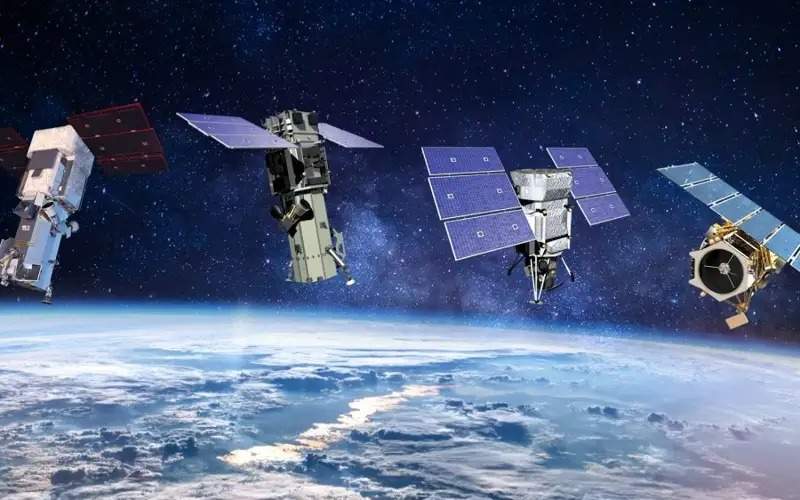
Science or military ambitions?
In April 2024, NASA Administrator Bill Nelson told the U.S. Congress that China has made remarkable progress in space, particularly over the past decade, but remains highly secretive.
“We believe that a lot of their so-called civilian space programme is a military programme. And I think, in effect, we are in a race,” Nelson stated.
While China’s true intentions in space remain unclear, the military focus of the U.S. space program is becoming increasingly evident. The U.S. Defense Department has expanded its military satellite services program in low Earth orbit (PLEO) from an initial $900m to $13 billion for the Defense Information Systems Agency (DISA) and Space Systems Command.
This expansion is driven by the growing demand for high-speed satellite internet for military operations, provided by systems like SpaceX’s Starlink.
The PLEO program has already spent approximately $660m of its initial $900m funding, with the majority of contracts fulfilled by Starshield, the military version of SpaceX’s Starlink service. SpaceX, controlled by Elon Musk, is expected to play an increasingly significant role in U.S. space investments and strategy.
Meanwhile, to counter Starlink, Beijing is developing three satellite constellations with a total of more than 10,000 satellites:
· G60 Starlink (Thousand Sails)
· The nationwide Guowang network
· Honghu-3, which is tied to the commercial rocket manufacturer LandSpace
US Space Command Commander Stephen Whiting has expressed concern over China’s progress, noting that the country has tripled its number of spy satellites in orbit over the past six years.
The battle for the Moon
Speaking before the U.S. House Appropriations Committee on NASA’s 2025 budget, NASA Administrator Bill Nelson emphasized that the US must return to the Moon before China. While both countries are pursuing lunar missions, he warned that if Beijing gets there first, it might declare the territory its own and tell others to stay away.
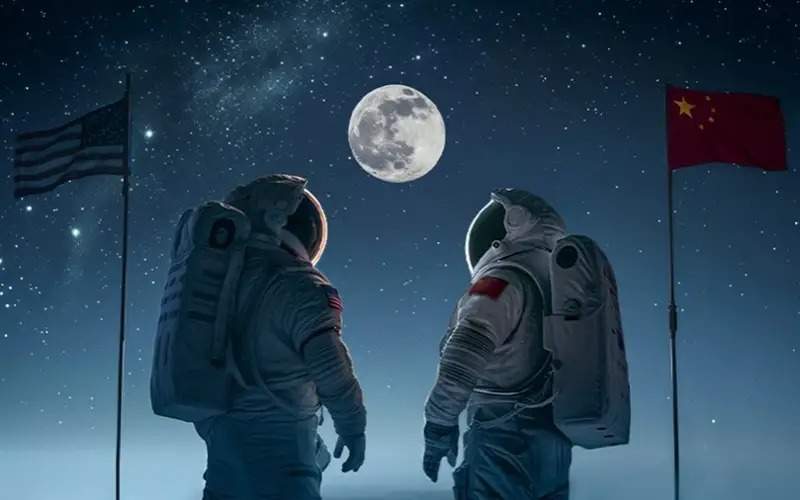
The U.S. plans to land astronauts on the Moon in 2028 as part of the Artemis 3 mission, while China has announced its goal of sending taikonauts to the Moon by 2030.
In May 2024, China launched the robotic Chang’e-6 spacecraft to the far side of the Moon. Its mission was to pave the way for China’s first crewed lunar landing and the construction of a base at the Moon’s south pole.
“On a geopolitical level, China’s space ambitions raise questions about how it might leverage its space capabilities to further its regional and domestic political and military interests,” said Svetla Ben-Itzhak, Deputy Director of the Western Space Scholars Program at Johns Hopkins University.
According to Kazuto Suzuki, professor at the Graduate School of Public Policy at the University of Tokyo, the U.S. and China are indeed in a space race, but it’s not just about landing on the Moon, as it was during the Cold War. Instead, it is a competition for resource exploration and control.
“It’s a race for who has better technical capabilities. China is quickly catching up. The pace of Chinese technological development is the threatening element to the US,” Suzuki noted.
He argues that while international agreements prohibit national appropriation of lunar resources, in reality, “it’s the wild, wild west”.
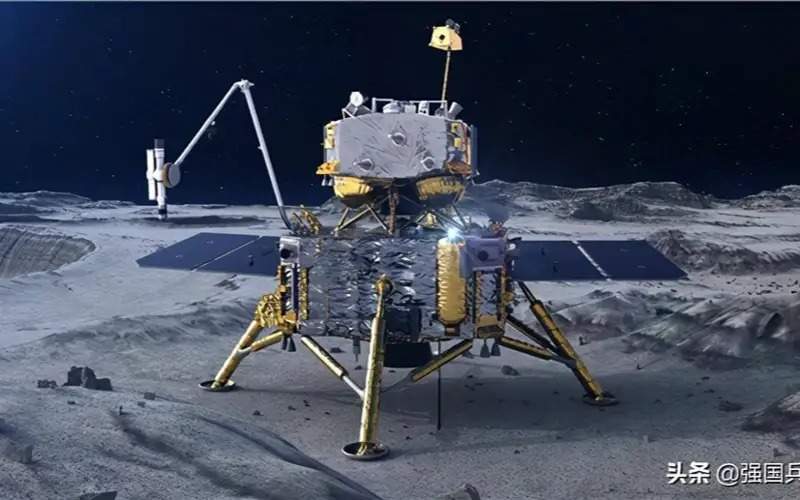
Both the US and China are leading the development of separate lunar space station programs. The US-led Artemis program includes plans for Lunar Gateway, a station in lunar orbit to serve as a communications hub and astronaut staging area, as well as a scientific laboratory.
Kazuto Suzuki notes that the US is less focused on claiming the Moon, having already been there. With its uninhabitable conditions, their priority lies in Mars exploration. According to Suzuki, the Lunar Gateway serves primarily as a refueling station for future Mars missions. If the Artemis program succeeds in extracting water from the Moon, it could be converted into rocket fuel using hydrogen and oxygen.
In contrast, China and Russia announced plans in 2021 to build the International Lunar Research Station (ILRS), along with a nuclear reactor to power it by 2035.
The US already has its massive Space Launch System (SLS), which stands at 98 meters tall and weighs 2,600 tons.
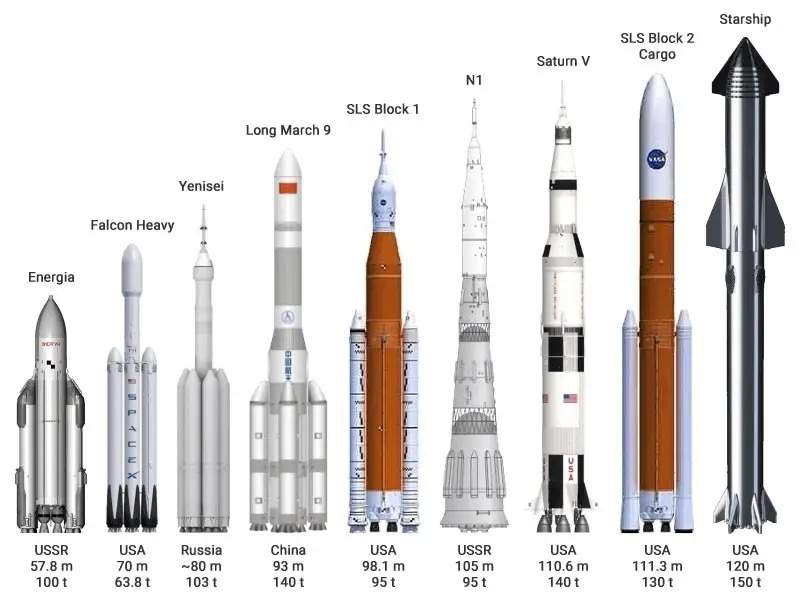
The SLS was tested in November 2022, successfully launching its payload into orbit and enabling the successful flight of a fully functional spacecraft around the Moon. Now, the NASA Artemis program only needs to repeat this process with astronauts on board.
China’s primary contender for a lunar rocket is the Long March 10. Standing 93 meters tall and weighing about 2,200 tons, it closely resembles the Space Launch System and can launch a lunar spacecraft into orbit. The issue is that this rocket is not yet ready. As of 2022-2023, Chinese engineers were still conducting ground tests on some of its engines and stationary tests on other systems. The first launch is scheduled for 2027.
China also has another rocket it could use to send astronauts and cargo to the Moon: the super-heavy Long March 9 or Changzheng 9. This rocket is massive, standing 114 meters tall and weighing 4,600 tons. It competes with Elon Musk’s Starship.
The key difference is that Starship has already had two test launches, though both were unsuccessful. In contrast, the Long March 9 exists mainly on paper, having been designed in 2016, and its first launch date has yet to be announced.
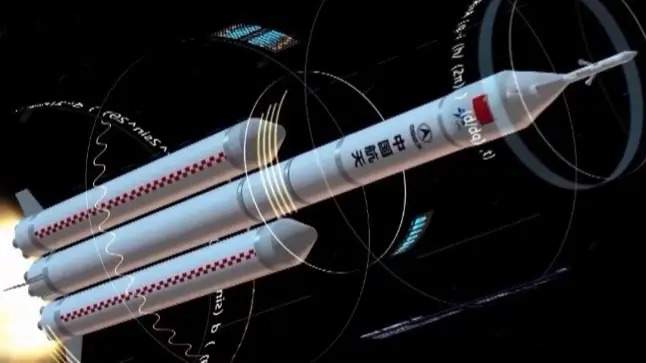
Space coalitions
Recently, the China National Space Administration (CNSA) has successfully established space partnerships with countries such as Saudi Arabia, the United Arab Emirates, Brazil, France, Belarus, Pakistan, Venezuela, Egypt, and 22 other African nations. This cooperation also extends within the framework of the BRICS group. The first meeting of the Joint Committee on Space Cooperation took place in May 2022. CNSA’s focus is on the International Lunar Research Station Cooperation Initiative (ILRSCO), which many view as a parallel project to the U.S.-led International Space Station or the Artemis Program.
In March 2021, CNSA and Russia’s Roscosmos signed a Memorandum of Understanding on cooperation for the International Lunar Research Station (ILRS). In April 2023, CNSA and the Asia-Pacific Space Cooperation Organization signed a joint statement on cooperation for international lunar research stations.
Since June 2023, countries including South Africa, Venezuela, Azerbaijan, Pakistan, Belarus, the UAE, Brazil, and Egypt have officially signed agreements and memorandums of cooperation within the framework of international lunar research.
China has established overseas space tracking stations in six countries: Australia, Chile, Kenya, Namibia, Pakistan, and Sweden. Additionally, China sells space technologies and services to many nations, including Algeria, Argentina, Belarus, Bolivia, France, Indonesia, Laos, Nigeria, Pakistan, Saudi Arabia, Sri Lanka, Thailand, and Venezuela. From 2007 to 2018, China launched 20 satellites for 13 countries.
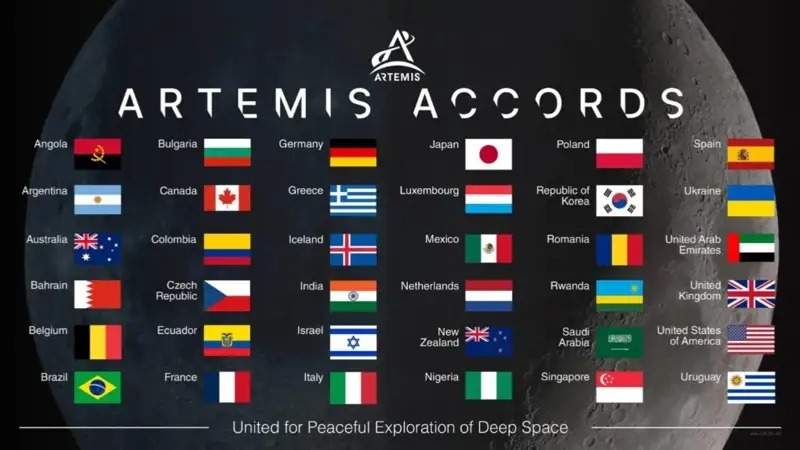
In turn, the U.S. launched the Artemis Accords, an international agreement that regulates principles for cooperation and peaceful exploration and use of the Moon, Mars, comets, and asteroids. The agreement has been signed by national space agencies from over 36 countries.
As the two space superpowers face numerous technical challenges and production tasks, each of which could cause significant delays, it remains too early to declare a winner in the new space race. It is also unclear how the creation of space coalitions, actively developed by both the US and China, will affect the final outcome.
At the same time, the recent restoration of military ties between the U.S. and China could foster cooperation between the two countries in the space sector. There are precedents for bilateral agreements between the U.S. and China on satellite launch responsibilities and lunar rock research.
Furthermore, collaboration on space debris management could become a key area of cooperation for space agencies worldwide and may serve as an opportunity for closer ties between the U.S. and China in space exploration.
Earlier, Kazinform News Agency reported that the Moon was added to the World Monuments Fund’s (WMF) 2025 Watch List for the first time.
Share this article:






